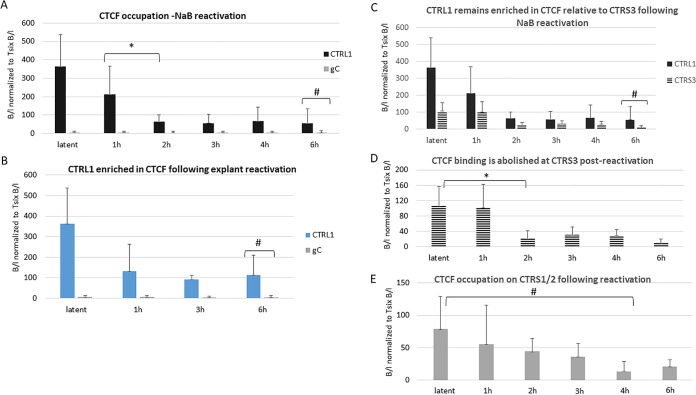FIG 3.
CTRL1 remains enriched in CTCF following reactivation. (A) Mice latently infected with HSV-1 17Syn+ were subjected to intraperitoneal treatment with sodium butyrate (NaB), and the TG were harvested at 1 h, 2 h, 3 h, 4 h, and 6 h. ChIP assays using anti-CTCF were combined with real-time PCR analyses to compare TG from NaB-treated mice and latently infected mouse TG at the CTRL1 site. Time following NaB treatment is represented on the x axis. The 0-h time point samples are from latently infected mice not subjected to NaB treatment. TG of three mice (6 TG) were pooled for each ChIP assay (n = 8 for each time point done). There was a significant decrease in CTCF occupation of this site by 2 h post-NaB treatment (>3-fold; *, P < 0.01), but the site remained significantly enriched in CTCF relative to the level of the negative control, gC (#, P < 0.05) (B) Explant-induced reactivation was done to confirm NaB results. TG of three mice (6 TG) were pooled for each ChIP assay (n = 8 for each time point done). Data are consistent with results for NaB-treated animals where CTCF is not completely evicted from the CTRL1 site (#, P < 0.05, one-way ANOVA). (C) CTRL1 is significantly more enriched than CTRS3 at 6 h postreactivation following NaB (#, P < 0.05). (D) CTCF binding at the CTRS3 site is significantly lower by 2 h (*, P < 0.01) and is essentially abolished by 6 h postreactivation. (E) CTCF is significantly lower at the CTRS1/2 sites by 4 h following NaB reactivation (#, P < 0.05). Statistical data were determined by one-way ANOVA by comparing the B/I ratios at each time point shown. It should be noted that latent samples are the same samples used in the experiment shown in Fig. 1B.

